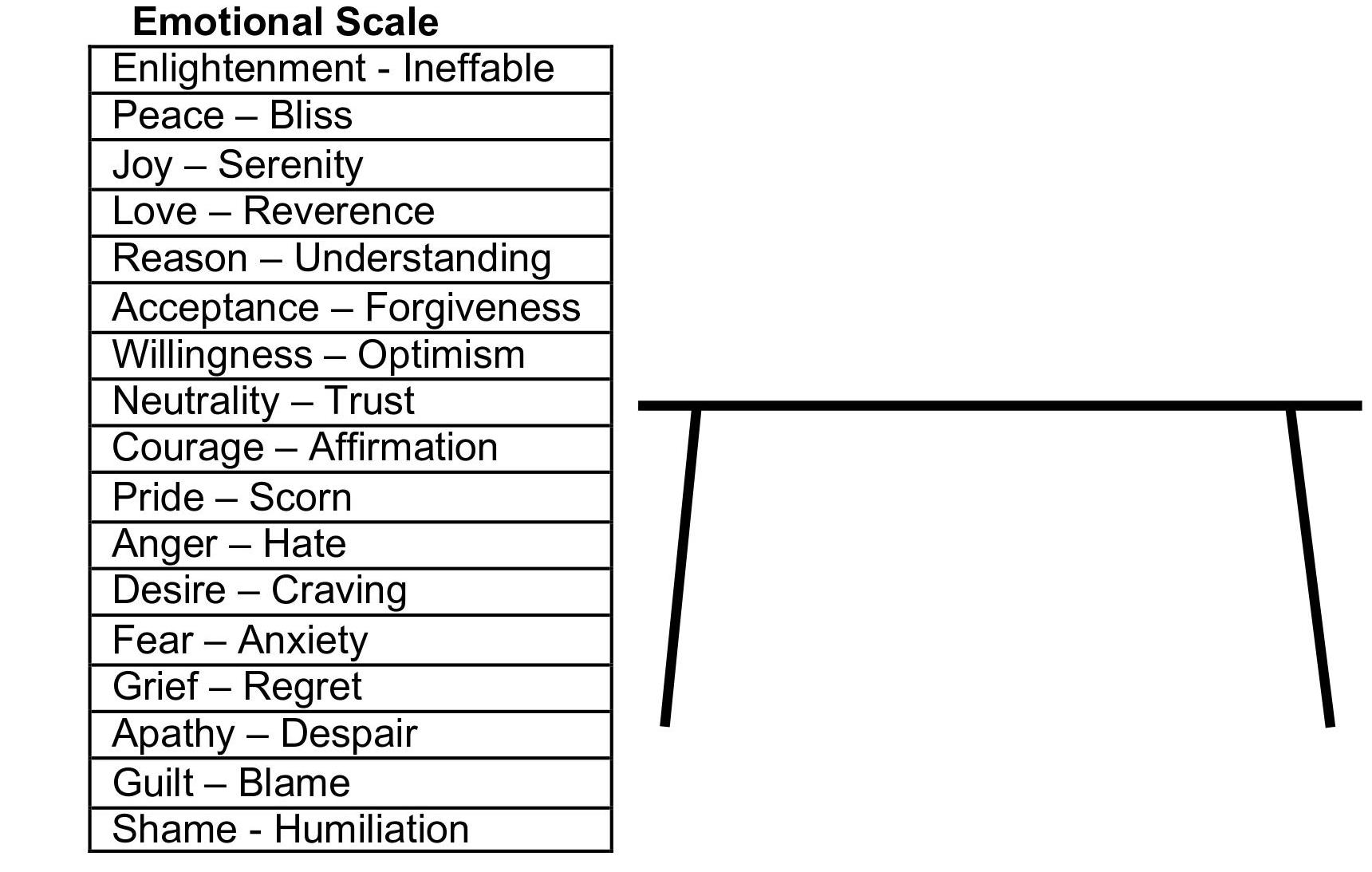 Image by mollyroselee from Pixabay
Image by mollyroselee from Pixabay
Approx. 5 minute read
Thank you for choosing to be here.
This is Part One in a series of articles to help you support and increase your emotional and mental well-being.
In this article, you’ll be reviewing two of the foundational principles you’ll need to move through the tools and concepts to follow.
The first two principles are understanding the emotional scale, and how thoughts, emotions, and behaviors are connected and invoked.
Emotional Scale
Humans live in a constant state of emotions, all day every day. It’s what we do. It’s who we are. Pretending it isn’t happening doesn’t make it so.
Review the hour prior to you being here. Reflect on the different emotions you experienced, even if they were only momentary blips.
Up and down you go, from fear to joy, down to despair, anger, frustration, then up to courage, and maybe even to love. A few years ago, I came across the work of Dr. David R. Hawkins, and his book Power vs. Force[1]. There is more to his work than I can describe here, but one aspect is that there is an emotional scale that relates to the state of our well-being. The lower on the scale we are, the worse we feel. The higher on the scale, the better we feel.

Yes, that’s a crude design of a table to the right of the chart . . . Note the tabletop is level with, Neutrality – Trust. That’s no accident.
For an average week, guesstimate what percentage of your waking time is above or below the tabletop, Neutrality – Trust.
If you’re anything like I was when I lived a middle-class corporate life, you’re probably below the tabletop the majority of the day. And you’re not alone.
Suicide rates are increasing[2]. Anxiety and depression affect almost 20% of the U.S. population[3]. And now humanity is dealing with COVID-19. Frightening stuff. However, let’s look to the future. Your future. Not where you are today on the emotional scale, but where you desire to be.
Think about this and give an honest answer (these concepts work best when you’re honest with yourself). Where would you like to be on the emotional scale, most of the time?
It’s unrealistic to aim for being above the tabletop all of the time. Life happens. Situations change. And in my opinion (and others), we’re here to experience all the emotions available to us. However, to experience life above the tabletop as much as possible is beneficial to your overall well-being.
Now you have an understanding of your desired emotional state(s) to aim toward as a long-term outcome for yourself. You have something to strive for. Keep this “front and center” as you move through these articles and your life.
Thoughts, Emotions, Behaviors
Your thoughts are powerful, which invoke your emotions and lead to your behaviors. This concept is a foundational principle for all the tools you will be learning. The concept is derived from Cognitive Behavioral Therapy (CBT) and Rational Emotive Behavior (REBT), which are used extensively by therapists and counselors alike.
You don’t do anything without thinking about something first. It works like this:

Here’s a simple example.
Triggering event: You’re walking down the street one day and you see someone you know coming your way. You smile, wave, and say, “Hi.” They ignore you and walk by.
Your possible Thoughts/Beliefs: What’s wrong? Doesn’t he remember me? Did I do something to upset him?
Those thoughts and beliefs might evoke Emotions such as sadness, rejection, anger, guilt, shame, or anxiousness.
This may lead to Actions/Behaviors such as: chewing your fingernails, reaching for a cigarette, or withdrawing and keeping your head down to avoid eye contact with others.
Think of two examples in your own life where an event (including memories) triggered negative/unhelpful thoughts/beliefs in you. Identify the triggering event and resulting thoughts/beliefs, emotions, and actions/behaviors.
Reflect on two other examples where an event triggered positive/joyful thoughts or beliefs in you. Once again, identify the triggering events, and the resulting thoughts/beliefs, emotions, and actions/behaviors.
Got the idea? Practice observing your emotional state. Take time to reflect when you’re experiencing a challenging emotion or unwanted behavior. Work backward to understand the triggering event and what you believed about it. Those beliefs are what trigger resulting emotions and behaviors.
Stay tuned for the next foundational principle: How You Learn.
If you’re interested in the free in-depth PDF workbook for these tools to help with critical thinking and emotional self-regulation, please email me at [email protected].
~~~~~
[1] Dr. David R. Hawkins: https://veritaspub.com/dr-hawkins/ Power vs. Force
[2] Suicide Rates: https://time.com/5609124/us-suicide-rate-increase/
[3] Anxiety and Depression: https://adaa.org/about-adaa/press-room/facts-statistics
~~~~~~
For more techniques and tools to modify behavior, check out my unique and engaging self-improvement novel, The Shift Squad.
 I write to inspire others to greater self-empowerment, authenticity, and improved emotional and mental well-being.
I write to inspire others to greater self-empowerment, authenticity, and improved emotional and mental well-being.
I am the author of the unique personal development novel The Shift Squad.
If you like what you read please subscribe for updates, share my articles with others, and add your comments below.
You can connect with me via email at [email protected] , on Facebook, Twitter, and LinkedIn.
Be Empowered. Make Authentic Choices And Enhance Your Quality Of Life.
